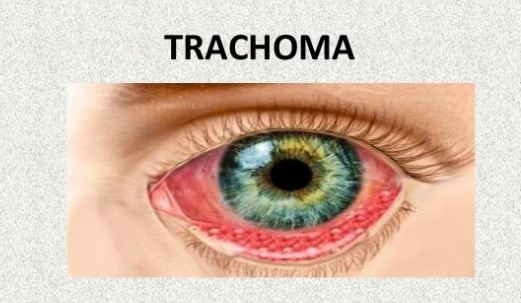Trachoma is a bacterial infection of the eye caused by the bacterium Chlamydia trachomatis. It is one of the leading preventable causes of blindness worldwide and is most prevalent in areas with poor sanitation and limited access to healthcare.
The infection is spread through contact with eye and nose discharge from infected individuals, as well as by flies that have come into contact with infected secretions. Repeated infections can lead to scarring of the inner eyelid, which can cause the eyelashes to turn inward and scratch the cornea, leading to blindness.

Symptoms of Trachoma
Symptoms of trachoma include:
- Eye redness
- Eye discharge
- Swollen eyelids
- Itching or irritation of the eyes
- Blurred vision
- Sensitivity to light
- Inverted eyelashes (trichiasis)
The infection is more common in children, but adults can also be affected. Risk factors for trachoma include poor sanitation, lack of access to clean water, overcrowding, and close contact with infected individuals.
Stage of Trachoma
Trachoma, caused by the bacterium Chlamydia trachomatis, has been identified by the World Health Organization (WHO) to develop in five stages.
- The first stage is characterized by the appearance of small bumps or follicles on the inner surface of the upper eyelid, which can only be seen with magnification.
- This stage is followed by intense inflammation of the eye, causing swelling and thickening of the upper eyelid.
- As the infection progresses, repeated episodes of inflammation can lead to scarring of the inner eyelid, which can distort the eyelid and cause it to turn inward (entropion).
- This, in turn, causes the eyelashes to rub on the cornea, leading to scratching and scarring, and eventually causing the eyelashes to turn inward (trichiasis).
- In the final stage, the cornea becomes affected by inflammation, which can cause clouding and opacity.
It is worth noting that all the signs of trachoma are generally more severe in the upper lid than in the lower lid. If left untreated, this disease can cause permanent vision loss and blindness. Trachoma typically begins in childhood and can continue to progress into adulthood, hence prompt intervention is necessary to prevent its advancement.
Risk factors or Causes of Trachoma
Several risk factors have been identified that contribute to the transmission and spread of the infection.
- Crowded living conditions, particularly in areas with limited access to clean water and sanitation, can contribute to the spread of trachoma. This is because the bacteria that cause trachoma can be easily transmitted through contact with contaminated surfaces, such as towels, clothing, and bedding.
- Poor sanitation is also a significant risk factor for trachoma. Lack of access to clean water for washing and personal hygiene can increase the likelihood of infection, as can the absence of proper waste disposal systems.
- Age is another factor that can increase the risk of trachoma. The infection is more common in children, particularly those aged 4 to 6 years, as their immune systems are still developing and they are more likely to come into contact with infected individuals or contaminated surfaces.
- Sex is also a factor, as women and girls are often responsible for household hygiene and may have a higher risk of infection due to their role in caring for younger siblings and family members.
- Flies are also a risk factor for trachoma, particularly in areas where they are abundant. Flies can come into contact with contaminated surfaces and then spread the bacteria to other individuals, increasing the likelihood of transmission.
Treatment of Trachoma
Antibiotics are effective in treating early cases of trachoma. Early treatment can prevent long-term complications. However, more advanced cases of trachoma may require surgery to correct eyelid scarring or in-turned eyelashes that can damage the cornea.
In order to prevent trachoma, the WHO has developed a “S.A.F.E.” strategy, which stands for:
- Surgery: For people with advanced cases of trachoma who have eyelid scarring or in-turned eyelashes (trichiasis), surgery may be necessary to correct the condition and prevent further damage to the cornea.
- Antibiotics: Antibiotics such as azithromycin can be used to treat active trachoma infections and prevent further transmission of the disease.
- Facial cleanliness: Frequent face washing and improved hygiene can help to reduce the spread of the disease by removing bacteria from the face and reducing the risk of transmission.
- Environmental improvements: Improving sanitation, access to clean water, and reducing the presence of flies can also help to prevent and control the spread of trachoma.
Early detection and treatment of trachoma is crucial for preventing long-term complications. Regular eye check-ups and consulting with an eye doctor can help to detect trachoma early and ensure that appropriate treatment is provided.








